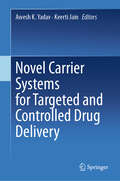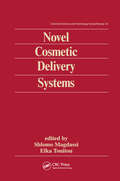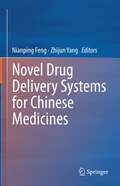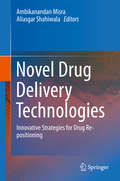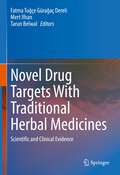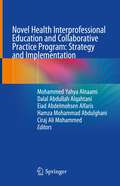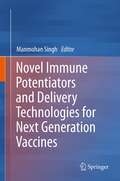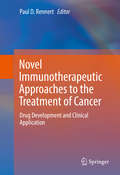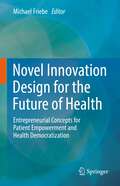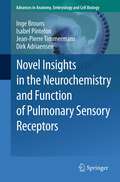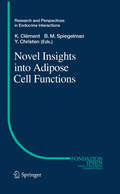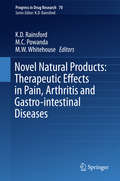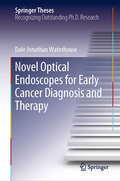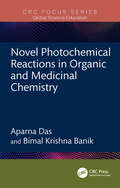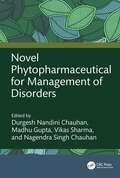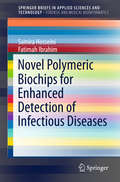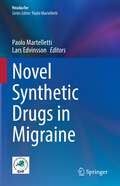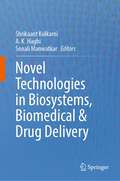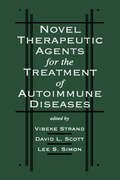- Table View
- List View
Novel Carrier Systems for Targeted and Controlled Drug Delivery
by Keerti Jain Awesh K. YadavThe book presents novel carrier systems for the targeted and controlled drug delivery for the treatment of various diseases which are difficult to be treated with conventional drug delivery systems like cancer, autoimmune disorders, and emerging infectious diseases. It also reviews the origins and applications of stimuli-responsive polymer systems and polymer therapeutics such as polymer-protein and polymer-drug conjugates. The book also explores the potential applications of the parenteral route of administration for the delivery of active pharmaceutical substances with a narrow therapeutic index and poor bioavailability. Further, the book presents common routes of administration for the systemic delivery of peptides and proteins. It also examines the applications of various implantable systems in drug delivery. The book also covers the important colloidal drug delivery systems, including liposomes and niosomes and solid lipid nanoparticles, and nanostructured lipid carriers. Towards,the end, the book discusses the therapeutic potential of biodegradable polymeric nanoparticles for controlled drug delivery. Authoritative and thorough, this book is a valuable resource for researchers working on a multidisciplinary approach to employing drug delivery systems.
Novel Coronavirus 2019: In-silico Vaccine Design and Drug Discovery (SpringerBriefs in Applied Sciences and Technology)
by Amit Kumar G. Jyothsna Amita Kashyap Ajit Kumar Saxena Gwo Giun LeeThis book highlights the genomic findings, observations, and analysis of DNA/RNA sequences and protein structure of the dreadful virus of this decade- COVID-19. The Corona group of viruses though known species, the strain that caused the Pandemic of 2019 is a completely new strain, belonging to the same corona family with a novel genetic make-up. This makes it a new pathogen which is causing the current outbreak leaving the global scientific community clueless of any therapeutic breakthrough. NCOV enjoys life threatening pathogenicity with mysterious genetic annotations. This book details and offers insights into its viral genetic arrangement, Virulence factors, probable mutations leading to the evolution of this new strain and more. It contains chapters on Virus evolutionary status and Genetic makeup leading to its pathogenicity which can be a new insight in understanding the nature of this clever microorganism and can pave way to the development of new drugs and Vaccines or a novel diagnostic approach for the early prognosis of the disease. A dedicated chapter on annotation of NCOV-19 virulence genes, translation of the genes to protein product, annotation of the antigenic sites on these proteins is also included. In all, this brief is a complete genomic annotation insight of NCOV-19 using AI, Data analytics and Bioinformatics analysis. In the current situation, this book is an extensive preliminary resource for Medical practitioners, Researchers, Academicians, Scientists, Biochemists, Bioinformaticians and other professionals interested in understanding the genetics of Novel Coronavirus 19, the best possible drug targets, ideal vaccine candidates and novel prognostic and diagnostic biomarkers.
Novel Cosmetic Delivery Systems (Cosmetic Science And Technology Ser. #19)
by Shlomo Magdassi Elka Touitou"Highlights the uses of delivery systems in cosmetics, analyzing new approaches for obtaining sophisticated cosmetic products and examining the most common methods for enhancing the skin's penetration properties. Covers a wide range of established and burgeoning techniques."
Novel Developments in Stem Cell Mobilization
by W. Jens Zeller Stefan Fruehauf Gary CalandraRecently the CXCR4/CXCL12-axis has been recognized as one of the pivotal adhesion pathways by which hematopoietic stem cells are retained in the bone marrow. CXCR4 antagonists with different chemical specification are being developed. Pharmacology research guides the way to the rational development effective antagonists. One antagonist, plerixafor, is clinically approved now for stem cell mobilization of lymphoma and myeloma patients. This allows patients to receive potentially life-saving treatment which could not have been administered otherwise. Through early clinical studies it was recognized that CXCR4 antagonists also mobilize malignant hematopoetic cells, i.e. leukemia cells. In preclinical studies a sensitization of mobilized leukemic cells to standard cytotoxic chemotherapy could be shown. Clinical studies are under way. CXCR4 antagonists are an exciting new class of compounds which are also employed for the mobilization of angiogenic cells or for the treatment of solid tumors. In this book a concise review of the current status of knowledge and future developments will be presented.
Novel Drug Delivery Systems for Chinese Medicines
by Nianping Feng Zhijun YangThis book describes the essential and cutting-edge concepts based on the frontier of pharmaceutical research in TCM, underlying scientific principles, and current advancements of drug delivery systems for Chinese medicines, including sustained-release drug delivery systems, trans-nasal drug delivery systems, dermal and transdermal drug delivery systems, etc. Novel carriers and emerging technologies (such as 3D printing) are also covered. The book provides readers with an overall picture of drug delivery systems for Chinese medicines and also yields benefits for the pharmaceutical industry with regard to TCM-based drug development.
Novel Drug Delivery Systems for Phytoconstituents
by Madhu Gupta Durgesh Nandini Chauhan Vikas Sharma Nagendra Singh ChauhanNovel Drug Delivery Systems for Phytoconstituents discusses general principles of drug targeting, construction material and technological concerns of different phytoconstituent in delivery systems. It focuses on the development of novel herbal formulations and summarizes their method of preparation, type of active ingredients, route of administration, biological activity and their applications. It dicusses therapeutic activities of plant derived chemicals, their limitations in clinical applications and novel drug delivery solutions to overcome them to provide better therapeutic effects with controlled and targeted drug delivery. Focus on drug delivery of phytomolecules Act as bridge between natural product scientist and clinical doctors Discusses mechanism of poor bioavailability of herbal molecules Increases awareness towards phytochemical efficacy Summarizes efficient novel delivery systems-based formulations. It extensively covers the applications of novel drug delivery systems including polymeric nanoparticles, solid lipid nanoparticles, nanostructured lipid capsules, liposomes, phytosomes, microsphere, transferosomes, and ethosomes. Some chapters are especially focused on anticancer phytodrugs, silymarin, andrographolide, berberine, and curcumin delivery with special emphasis on their application.
Novel Drug Delivery Technologies: Innovative Strategies for Drug Re-positioning
by Ambikanandan Misra Aliasgar ShahiwalaThe application of drug delivery is a valuable, cost-effective lifecycle management resource. By endowing drugs with new and innovative therapeutic benefits, drug delivery systems extend products’ profitable lifecycle, giving pharmaceutical companies competitive and financial advantages, and providing patients with improved medications. Formulation development is now being used to create new dosage forms for existing products, which not only reduces the time and expense involved in new drug development, but also helps with regard to patent protection and bypassing existing patents. Today’s culture demands convenience, a major factor determining adherence to drug therapy. Over the past few years, patient convenience-oriented research in the field of drug delivery has yielded a range of innovative drug-delivery options. As a result, various drug-delivery systems, including medicated chewing gums, oral dispersible tablets, medicated lozenges and lollipops, have now hit the market and are very popular. These dosage forms offer a highly convenient way to dose medications, not only for special population groups with swallowing difficulties, such as children and the elderly, but for the general populace as well. This book provides valuable insights into a number of formulation design approaches that are currently being used, or could be used, to provide new benefits from existing drug molecules.
Novel Drug Targets With Traditional Herbal Medicines: Scientific and Clinical Evidence
by Tarun Belwal Fatma Tuğçe Gürağaç Dereli Mert IlhanThis book collects information about the most popular ethnomedicinal plants, which are common in Turkey and around the world. It presents the ethnopharmacological records, in vivo and in vitro studies, side effects, chemical compositions and clinical studies of these medicinal plants. Its special focus is on the novel drug targets for disease and their possible mechanisms of action. It covers botanical descriptions the status of the plants, and food or drug interactions including precautions and warnings about the plants and the available market products. It provides an explanation of recorded and known plant administration dosages. Also, the gap between the traditional practice and scientific/clinical evidences in the use of ethnomedicinal plant is acknowledged.It is well known that traditional knowledge of the use of the medicinal plants in therapy is an important resource for the discovery of novel treatment options and drug targets. The main purpose of this book is to draw attention to ethnomedicinal plant species. Data on the therapeutic potentials of these medicinal plants can now be accessed from a single source. It provides an important resource for future research opportunities for harnessing the full potential of these plants.
Novel Health Interprofessional Education and Collaborative Practice Program: Strategy and Implementation
by Mohammed Yahya Alnaami Dalal Abdullah Alqahtani Eiad Abdelmohsen Alfaris Hamza Mohammad Abdulghani Ciraj Ali MohammedThis book describes a novel health interprofessional education and collaborative practice (IPECP) program established at King Saud University (KSU), Riyadh, Kingdom of Saudi Arabia. The book has three main sections. The first section introduces interprofessional education's background, theory, and context for collaborative practice. This section elaborates on defining and developing centers of excellence in IPECP, defining and exploring the meaning of interprofessional collaborative practice in contemporary health care, theories of the team working relevant to health and social care systems, and learning in and about interprofessional groups and broader collaboration. The second section explains how to formulate and implement strategies for effective IPECP. It involves developing and implementing a novel health IPECP curriculum, governance, IPECP's impact and implications on health care outcomes, IPE accreditation standards, regulatory policies, and legal structures. The third section describes the result of a case study of an IPECP program established at KSU. This program is developed by the vice-rectorship for health specialties at KSU (VRHS-KSU) in collaboration with partners harvard medical international (PHMI) to enhance health professional education further through interprofessional education and collaboration. For that purpose, a strategic plan is developed to develop learning, teaching, and assessment in all health sciences colleges (HSCs), along with a governance structure to establish a joint "center of excellence in interprofessional education and collaborative practice (CoE-IPECP)". The strategic plan and design of the program summarized in this book were accomplished through several meetings, workshops, and courses conducted at KSU in Riyadh, and harvard macy institute (HMI) in Boston, USA. The toolkit for successful program implementation includes a pro forma business plan, implementation groups' training, matching needs with feasibility, and expected impact on HSCs. Initiation of pilot projects started with implementing some interprofessional courses, establishing an initial physical and IT infrastructure of the center, developing the webpage, newsletter, and listservs, and improving faculty development programs to enhance IPECP at HSCs. Also, this book is a helpful road map for other national and international universities and institutes aiming to develop their professional health education, particularly interprofessional education and collaborative practice.
Novel Immune Potentiators and Delivery Technologies for Next Generation Vaccines
by Manmohan SinghDevelopment of new-generation vaccines is now more challenging than ever, as identifying, purifying and evaluating vaccine antigens is a complex undertaking. Most importantly, once the relevant antigens have been identified, key focus then shifts to the development of suitable delivery systems and formulations to achieve maximum in vivo potency with minimum potential side effects. These novel formulations--many of which will be nanoparticulates--can deliver the antigens to the desired site, to the relevant antigen presenting cells, and prevent systemic exposure of the immune potentiators. The proposed book will outline all the critical steps that need to be considered for successful development of various types of nanoparticulate delivery systems for vaccine antigens. These contributions from leading experts in the area of vaccine formulation and delivery systems will tie in what is the most current status, including clinical evaluations with these novel vaccine technologies.
Novel Immunotherapeutic Approaches to the Treatment of Cancer
by Paul D. RennertCancer care is undergoing a radical transformation as novel technologies are directed toward new treatments and personalized medicine. The most dramatic advances in the treatment of cancer have come from therapeutics that augment the immune response to tumors. The immune checkpoint inhibitors are the best-known and most highly advanced examples of Immune Therapeutics targeting tumor cells and include approved antibody drugs directed at the cell surface proteins CTLA4 and PD-1. These are now considered foundational treatments for several solid tumor indications, and that list of indications is growing quickly. More broadly, antibodies have become workhorse molecules across the entire immunotherapy landscape. Antibodies to novel targets modulate the activity of diverse immune cell regulatory proteins. Engineered antibodies can induce tumor cell death or expose tumor cells to poisonous toxins (ADCC and ADC, respectively). Bi-specific antibodies can engage multiple tumor targets simultaneously, or can redirect lymphocytes to attack tumor cells. The antigen-binding domains within antibodies can be spliced onto cell stimulatory domains and transduced into T cells or NK cells, creating remarkable tumor-specific cellular therapeutics (CAR-T, CAR-NK). Beyond antibody-based therapies there are highly diverse and differentiated technology tool kits being applied to immunotherapy. Small molecule drugs are being developed to attack the tumor microenvironment, novel tumor vaccine approaches are showing great promise, patient lymphocytes are being isolated, expanded and reintroduced to patients, gene-editing techniques are becoming widely deployed, and a vast number of new tumor targets, and mutated tumor proteins (neoantigens), are being discovered. The past decade has seen unprecedented success in the treatment of diverse cancers. The authors of this volume have been asked to not only review progress to date, but importantly, to look ahead, and anticipate the evolution of cancer treatment across diverse Immune Therapeutic approaches. Our hypothesis is that the advances we are seeing across the immunotherapy landscape will further evolve and synergize, leading us finally to outright cures for many cancers.
Novel Innovation Design for the Future of Health: Entrepreneurial Concepts for Patient Empowerment and Health Democratization
by Michael FriebeThis book highlights the reasons for an urgently needed revision of the current global healthcare setup, discusses the needed mindset for a future of health, and provides a comprehensive development toolset for disruption (and for the needed incremental innovations towards disruption).Today’s biomedical and health innovation related research in universities encourages activities that lead to incremental innovations with a relatively low risk of failure. The healthcare industry on the other hand provides tools and devices for established healthcare providers to improve the diagnosis and therapy/ treatment of the patients’ health problems. The patient is not in the center of healthcare provision however, and prevention and prediction are not core goals. The current health setup needs to be challenged and disrupted.Disruptions are coming from technologies or processes that lead to a significant (>10x) reduction in cost or price/ performance and that also come with new business models. The need for change, effects of exponential technologies, and the needed shift to prevention and to homecare for health democratization and patient empowerment will be discussed in detail in the first parts of the book. The subsequent sections address several innovation methods with a focus on a novel meta methodology named Purpose Launchpad Health. This is followed by a comprehensive discussion on health entrepreneurship activities and needs. The final section of the book addresses how to train students to become entrepreneurial health innovators, presenting successful curricula and examples of health incubation and accelerator setups. All of the innovation tools presented and used in this book are summarized in the final chapter to help the reader get started planning an entrepreneurial venture.Written by experts from academia and industry, the book covers important basics and best practices, as well as recent developments. Chapters are concise and enriched with key messages, learning objectives and real innovation examples to bridge theory and practice. This book aims to serve as a teaching base for health innovation design and to prepare for health-related entrepreneurial ventures.Readers with medical, biomedical, biotechnology, and health economics backgrounds - and anyone who wants to become a future oriented health innovator or who believes in disruptive approaches - will find this book a useful resource and teaching tool for developing validated products/ services and processes for the future of health.
Novel Insights in the Neurochemistry and Function of Pulmonary Sensory Receptors
by Isabel Pintelon Dirk Adriaensen Jean-Pierre Timmermans Inge BrounsWith the advances of immunohistochemistry in combination with confocal microscopy, airway sensory receptor end-organs can now be examined and evaluated objectively. Based on their 'neurochemical coding', morphology, location and origin, three sensory receptor end organs are currently morphologically well-characterised: smooth muscle-associated airway receptors (SMARs), neuroepithelial bodies (NEBs) and visceral pleura receptors (VPRs). The present information on the functional morphological and neurochemical characteristics of these sensory receptors, leads to important conclusions about their (possible) function.
Novel Insights into Adipose Cell Functions
by Bruce M. Spiegelman Karine ClémentObesity is a disease of society and economic transition spreading at an epidemic pace throughout the world. According to the World Health Organization, obesity is defined as an increased or abnormal accumulation of body fat mass to the extent that individual's health will be negatively affected. Overweight is thus being considered as top at risk condition in the world and it is mandatory to identify the physiopathological causes involved in adipose tissue enlargement and related metabolic and cardiovascular health disorders.This volume provides the most up to date insights into the biology of a complex endocrine organ: the adipose tissue.
Novel Natural Products: Therapeutic Effects in Pain, Arthritis and Gastro-intestinal Diseases
by K. D. Rainsford M. C. Powanda M. W. WhitehouseIn recent years there have been a number of significant developments of natural products for the treatment of rheumatic diseases, pain and gastro-intestinal ulcers and inflammation. The volume covers some of these novel developments of natural products which are of current and future interest as therapies for the above-mentioned conditions. Most available volumes cover a wide range of biological and technicological aspects of natural products and their discovery, some involving synthesis and properties of chemical compounds. The difference in this volume is that the natural products have a focus on their therapeutic effects on pain, arthritic and gastrointestinal diseases. Some of the natural products covered are either at the experimental stage of development while others are well-established clinically-used products. Each has its own unique place in therapy.
Novel Optical Endoscopes for Early Cancer Diagnosis and Therapy (Springer Theses)
by Dale Jonathan WaterhouseThis thesis describes the design, development, characterisation and clinical translation of three novel devices for optical endoscopic imaging. Over the past decade, rapid innovation in optics and photonics has led to the availability of low-cost and high-performance optical technologies that can be exploited for biomedical applications, but relatively few have been translated into clinic. The work presented outlines for the first time, a comprehensive analysis of the common barriers and unique challenges associated with the translation of optical imaging techniques. To assist developers streamline translation of optical imaging devices in future, a roadmap to clinical translation is outlined, and key translational characteristics are defined. Guided by these, subsequent development of endoscopic devices resulted in preparation and approval of endoscopes for first in human trials in the oesophagus, for early detection of cancer, and in the brain, for delineation of tumour during surgical resection. The thesis culminates in the presentation of results from the first in human use of a compact multispectral endoscope for imaging endogenous tissue contrast in the oesophagus. With continuation of the work as outlined at the end of this thesis, the novel techniques described have the potential to improve the standard of care in their respective indications.
Novel Photochemical Reactions in Organic and Medicinal Chemistry (Global Science Education)
by Bimal Krishna Banik Aparna DasThis book deals with chemical reactions which are triggered when light energy is absorbed by a substance’s molecules. It highlights the synthesis, molecular mechanism, chemical and biological properties of organic compounds and also focuses on recent advances in drug development related to cancer and other ailments. It will be helpful for researchers during target identification, lead identification, and optimization during the drug development process as well as in designing new molecules based on the data retrieved from the literature survey.Features: • Methods for creating carbon-carbon and carbon-heteroatom bonds following green chemistry and concepts on electron-donor-acceptor pathways.• Focuses on medicinally important molecules, in particular against diverse cancers.• Describes synthesis of natural products.• Describe economical and practical pathways.• Encourages new ways to conduct research in organic and medicinal chemistry.This book will be beneficial to undergraduates, postgraduates, research scholars, and young teachers in chemistry and biological science, pharmacists, pharmacologists, clinicians, industrialists, and biochemists.
Novel Phytopharmaceutical for Management of Disorders
by Madhu Gupta Durgesh Nandini Chauhan Vikas Sharma Nagendra Singh ChauhanNovel Phytopharmaceutical for Management of Disorders covers recent advances surrounding phytopharmaceuticals and their potential uses in the management of several disorders as well as in cosmetic benefits. Sections cover the concepts of phytopharmaceuticals and current highlights in disease management. This book also emphasizes phytopharmaceutical drug delivery studies in vivo–in vitro study to various target organs like lungs, liver, and brain. This book provides key information for everyone interested in disease management, drug discovery, and delivery, including medicinal chemists, cosmetic experts, nutritionists, toxicologists, drug formulators, and health care professionals. Students, professors, and researchers working in pharmaceutical sciences and beyond will also find the book useful considering the future prospect of phytodrug delivery for better treatment of various diseases.We will also focus on patents filed, technology transfer, market potential, and regulatory aspects of herbal nanomedicines, if any. However, research in this area is still at the exploratory stage. But, in the market, there are no such books available that have summarized all the contents on the point of research aspects. This book will be a continuation of the first volume and readers and the target audience will get all the knowledge related to this topic.Aims and scope: To understand the basic information and application of phytoconstituents To understand the various phytoconstituents-based formulations for disease management Herbal drugs used for cosmetic application Phytodrug delivery systems and their applications To provide detailed knowledge about the technical aspects of the formulation part To update readers with the latest research progress in this emerging research area To provide the details about patents filed, technology transfer, market potential, and regulatory aspects for the same
Novel Plant Imaging and Analysis: Water, Elements and Gas, Utilizing Radiation and Radioisotopes
by Tomoko M. NakanishiThis open access book is only an introduction to show that radiation and radioisotopes (RI) are premier tools to study living plant physiology which leads to new findings. Who had ever imagined that we could see water in a plant? Who had ever imagined that we could see ions moving toward roots in solution? Who had ever imagined that we could see invisible gas (CO2) fixation and movement in a plant? These studies demonstrated for the first time that water, ions and gas can be visualized in living plants, which could be hardly seen by anyone before. This publication summarizes the results obtained by Nakanishi’s lab in The Univ. of Tokyo, based on her original concept and her original tools or systems. It is useful for professional scientists, plant physiologist, and those studying plant imaging. The chapters demonstrates the innovative imaging work of the author, using radioactive tracers and neutron beam to follow the absorption and transport manner of water as well as major, minor, and trace elements in plants. Through these studies the author developed a real-time macroscopic and microscopic imaging system able to apply commercially available gamma- and beta-ray emitters. The real-time movement of the elements is now possible by using 14C, 18F, 22Na, 28Mg, 32P, 33P, 35S, 42K, 45Ca, 48V, 54Mn, 55Fe, 59Fe, 65Zn, 86Rb, 109Cd, and 137Cs. The imaging methods was applied to study the effect of 137Cs following 3/11 Fukushima Daiichi nuclear plant accident, which has revealed the movements of radiocesium in the contaminated sites.
Novel Polymeric Biochips for Enhanced Detection of Infectious Diseases
by Samira Hosseini Fatimah IbrahimThis book focuses on the creation and development of polymeric platforms(different compositions) from a specific polymer system. This system can be used as an adaptive technique for producing sensitive analytical devices,or for simple integration intoexisting bioanalytical tools in order to enhance the detection signal.
Novel Synthetic Drugs in Migraine (Headache)
by Paolo Martelletti Lars EdvinssonPublished in the series Headache, endorsed by the European Headache Federation, this is the first book on the novel synthetic treatment of migraine with ditans (lasmiditan) and gepants (atogepant, ubrogepant, rimegepant, vazegepant). These drugs will provide additional options for people with migraine put at risk of side effects by other medications or with unsatisfactory response to previous drugs. There is now a sufficient amount of literature published to interest a wide multidisciplinary readership (general physicians, general neurologists, clinical psychologists, neurologists in training, and medical students) facing every day this burdensome disorder in their clinical practice. The book aims therefore at offering an overview of these new drugs for both acute and prophylactic treatments of migraine, covering studies on clinical evidence, tolerability, and the different stages of clinical development.
Novel Technologies for Vaccine Development
by Igor S Lukashevich Haval ShirwanThis book presents a detailed overview of the development of new viral vector-based vaccines before discussing two major applications: preventive vaccines for infectious diseases and therapeutic cancer vaccines. Viral vector-based vaccines hold a great potential for development into successful pharmaceutical products and several examples at the advanced pre-clinical or clinical stage are presented. Nevertheless, the most efforts were focused on novel and very innovative technologies for new generation of vector-based vaccines. Furthermore, specific topics such as delivery and adjuvant and protection strategies for cell-mediated-based vaccines are presented. Given its scope, the book is a "must read" for all those involved in vaccine development, both in academia and industrial vaccine development.
Novel Technologies in Biosystems, Biomedical & Drug Delivery
by A. K. Haghi Shrikaant Kulkarni Sonali ManwatkarThe book gives an insight into the theoretical background, conceptual understanding, latest developments, and applications in the field of pharmaceuticals in general and drug design, discovery, biosystems, and biomedical and drug delivery technologies in particular. Knowledge is drawn from various disciplines such as Chemistry, Biology, Material Science and Engineering, Statistics, Biomedicine, and Genetics . A host of applications like bio-imaging, novel biological agents, testing, characterization and validation of drugs, computer-based models in drug design, and application of statistical tools in data analysis, design, and development of drug delivery systems, and ecosystems are dealt with in detail. The said book undoubtedly confirms the requirements of the postgraduate students, research scholars, academicians, scientists, and researchers from the academia, pharmaceutical, biotechnology, and chemical engineering domain. The book covers a conceptual understanding of the exploration of drugs in tandem with intended uses, sound ecosystem development, and carriers for drug and supplement delivery.
Novel Therapeutic Agents for the Treatment of Autoimmune Diseases
by Vibeke Strand David L. Scot Lee S. SimonProvides a detailed survey of therapies for autoimmune diseases, exploring the rationale for their use and clinical data regarding their potential benefit.
Novel Therapeutics for Rare Lymphomas
by Christopher DittusThis comprehensive volume reviews the clinical presentation, diagnosis, and treatment approach to rare lymphomas. There is particular emphasis placed on new diagnostic approaches, novel chemotherapy combinations, and treatment modalities with novel therapeutics. It highlights research advances in a group of diseases that are often overlooked, and serves as a single repository of information on the most recent advances in targeted small molecule inhibitors, monoclonal antibodies, immunotherapy, and CAR-T therapy as they pertain to rare types of lymphoma. Written for practicing oncologists, hematologists, fellows, and residents, Novel Therapeutics for Rare Lymphomas covers rare subtypes of lymphoma, including indolent and aggressive T-cell lymphomas and B-cell lymphomas.
